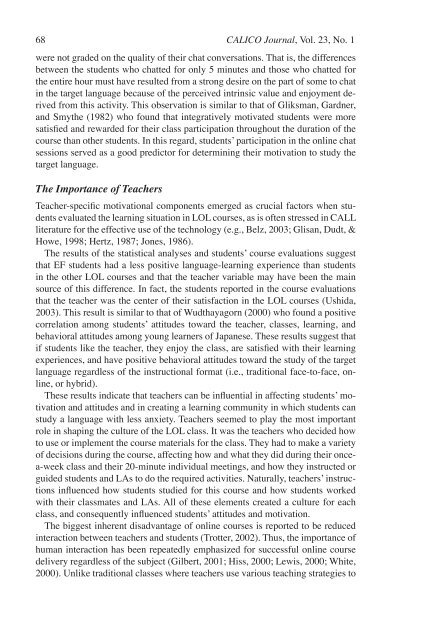The Role of Students' Attitudes and Motivation in Second ... - CALICO
The Role of Students' Attitudes and Motivation in Second ... - CALICO
The Role of Students' Attitudes and Motivation in Second ... - CALICO
You also want an ePaper? Increase the reach of your titles
YUMPU automatically turns print PDFs into web optimized ePapers that Google loves.
68 <strong>CALICO</strong> Journal, Vol. 23, No. 1<br />
were not graded on the quality <strong>of</strong> their chat conversations. That is, the differences<br />
between the students who chatted for only 5 m<strong>in</strong>utes <strong>and</strong> those who chatted for<br />
the entire hour must have resulted from a strong desire on the part <strong>of</strong> some to chat<br />
<strong>in</strong> the target language because <strong>of</strong> the perceived <strong>in</strong>tr<strong>in</strong>sic value <strong>and</strong> enjoyment derived<br />
from this activity. This observation is similar to that <strong>of</strong> Gliksman, Gardner,<br />
<strong>and</strong> Smythe (1982) who found that <strong>in</strong>tegratively motivated students were more<br />
satisfied <strong>and</strong> rewarded for their class participation throughout the duration <strong>of</strong> the<br />
course than other students. In this regard, students’ participation <strong>in</strong> the onl<strong>in</strong>e chat<br />
sessions served as a good predictor for determ<strong>in</strong><strong>in</strong>g their motivation to study the<br />
target language.<br />
<strong>The</strong> Importance <strong>of</strong> Teachers<br />
Teacher-specific motivational components emerged as crucial factors when students<br />
evaluated the learn<strong>in</strong>g situation <strong>in</strong> LOL courses, as is <strong>of</strong>ten stressed <strong>in</strong> CALL<br />
literature for the effective use <strong>of</strong> the technology (e.g., Belz, 2003; Glisan, Dudt, &<br />
Howe, 1998; Hertz, 1987; Jones, 1986).<br />
<strong>The</strong> results <strong>of</strong> the statistical analyses <strong>and</strong> students’ course evaluations suggest<br />
that EF students had a less positive language-learn<strong>in</strong>g experience than students<br />
<strong>in</strong> the other LOL courses <strong>and</strong> that the teacher variable may have been the ma<strong>in</strong><br />
source <strong>of</strong> this difference. In fact, the students reported <strong>in</strong> the course evaluations<br />
that the teacher was the center <strong>of</strong> their satisfaction <strong>in</strong> the LOL courses (Ushida,<br />
2003). This result is similar to that <strong>of</strong> Wudthayagorn (2000) who found a positive<br />
correlation among students’ attitudes toward the teacher, classes, learn<strong>in</strong>g, <strong>and</strong><br />
behavioral attitudes among young learners <strong>of</strong> Japanese. <strong>The</strong>se results suggest that<br />
if students like the teacher, they enjoy the class, are satisfied with their learn<strong>in</strong>g<br />
experiences, <strong>and</strong> have positive behavioral attitudes toward the study <strong>of</strong> the target<br />
language regardless <strong>of</strong> the <strong>in</strong>structional format (i.e., traditional face-to-face, onl<strong>in</strong>e,<br />
or hybrid).<br />
<strong>The</strong>se results <strong>in</strong>dicate that teachers can be <strong>in</strong>fluential <strong>in</strong> affect<strong>in</strong>g students’ motivation<br />
<strong>and</strong> attitudes <strong>and</strong> <strong>in</strong> creat<strong>in</strong>g a learn<strong>in</strong>g community <strong>in</strong> which students can<br />
study a language with less anxiety. Teachers seemed to play the most important<br />
role <strong>in</strong> shap<strong>in</strong>g the culture <strong>of</strong> the LOL class. It was the teachers who decided how<br />
to use or implement the course materials for the class. <strong>The</strong>y had to make a variety<br />
<strong>of</strong> decisions dur<strong>in</strong>g the course, affect<strong>in</strong>g how <strong>and</strong> what they did dur<strong>in</strong>g their oncea-week<br />
class <strong>and</strong> their 20-m<strong>in</strong>ute <strong>in</strong>dividual meet<strong>in</strong>gs, <strong>and</strong> how they <strong>in</strong>structed or<br />
guided students <strong>and</strong> LAs to do the required activities. Naturally, teachers’ <strong>in</strong>structions<br />
<strong>in</strong>fluenced how students studied for this course <strong>and</strong> how students worked<br />
with their classmates <strong>and</strong> LAs. All <strong>of</strong> these elements created a culture for each<br />
class, <strong>and</strong> consequently <strong>in</strong>fluenced students’ attitudes <strong>and</strong> motivation.<br />
<strong>The</strong> biggest <strong>in</strong>herent disadvantage <strong>of</strong> onl<strong>in</strong>e courses is reported to be reduced<br />
<strong>in</strong>teraction between teachers <strong>and</strong> students (Trotter, 2002). Thus, the importance <strong>of</strong><br />
human <strong>in</strong>teraction has been repeatedly emphasized for successful onl<strong>in</strong>e course<br />
delivery regardless <strong>of</strong> the subject (Gilbert, 2001; Hiss, 2000; Lewis, 2000; White,<br />
2000). Unlike traditional classes where teachers use various teach<strong>in</strong>g strategies to
















